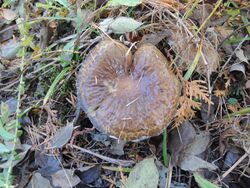Biology:Suillus serotinus
| Suillus serotinus | |
|---|---|

| |
| Scientific classification | |
| Domain: | Eukaryota |
| Kingdom: | Fungi |
| Division: | Basidiomycota |
| Class: | Agaricomycetes |
| Order: | Boletales |
| Family: | Suillaceae |
| Genus: | Suillus |
| Species: | S. serotinus
|
| Binomial name | |
| Suillus serotinus (Frost) Kretzer & T.D.Bruns (1996)
| |
| Synonyms[1] | |
| |
Suillus serotinus is a species of bolete fungus found in eastern North America. Originally described as a species of Boletus by American botanist Charles Christopher Frost in 1874,[2] it was transferred to Suillus in 1996.[3] The bolete has a dark red brown and sticky cap up to 12 cm (4.7 in) in diameter. The pore surface is initially white before turning reddish brown in age; the angular pores number from 1 to 3 per millimeter. Mushroom flesh slowly stains bluish after injury, later becoming purplish gray then finally reddish brown. The fungus grows in a mycorrhizal association with larch and fruits on the ground scattered or in groups. The spore print is purplish brown; spores are oblong to ellipsoid, smooth, and measure 8–12 by 4–5 µm. The fruit bodies are edible, but lack any distinctive taste or odor.[4]
See also
References
- ↑ "Suillus serotinus (Frost) Kretzer & T.D. Bruns". Species Fungorum. CAB International. http://www.speciesfungorum.org/GSD/GSDspecies.asp?RecordID=415952. Retrieved 2014-12-03.
- ↑ Frost CC. (1874). "Catalogue of Boleti of New England, with descriptions of new species". Bulletin of the Buffalo Society of Natural Sciences 2: 100–5. https://archive.org/stream/bulletinofbuffal12buff#page/100/mode/2up.
- ↑ "Internal transcribed spacer sequences from 38 recognized species of Suillus sensu lato: Phylogenetic and taxonomic implications". Mycologia 88 (5): 776–85. 1996. doi:10.2307/3760972. http://nature.berkeley.edu/brunslab/papers/kretzer1996.pdf.
- ↑ North American Boletes: A Color Guide to the Fleshy Pored Mushrooms. Syracuse, New York: Syracuse University Press. 2000. p. 179. ISBN 978-0-8156-0588-1. https://books.google.com/books?id=geiwy6Jf_ZcC&pg=PA179.
External links
Wikidata ☰ Q20720291 entry
 |

